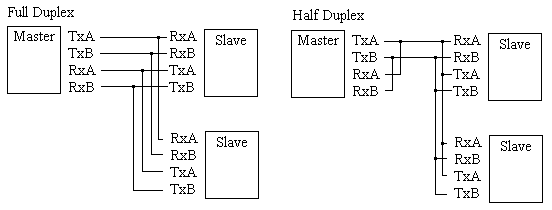
A Made IT project
http://www.made-it.com
info@made-it.com
 |
A Made IT projecthttp://www.made-it.com info@made-it.com |
General
RS485 is a balanced serial interface for the transmission of digital data. The advantage of a balanced signal is the greater immunity to noise. The difference between RS422 and RS485 is the fact that RS485 has the possibility to built a multi-point application.
Technical Description
The data is coded as a differential voltage between the wires. The wires are named A (negative) and B (positive). When B > A then the output is a mark (1 or off) and when A > B then it is counted as a space (0 or on).
In general a mark is +1 Vdc for the A line and +4 Vdc for the B line.
A space is +1 Vdc for the B line and +4Vdc for the A line.
At the transmitter end the voltage difference should not be less than 1.5 Vdc and not exceed 5 Vdc.
At the receiver end the voltage difference should not be less than 0.2 Vdc. The minimum voltage level is -7 Vdc and maximum +12 Vdc.
| Max. Distance @ Rate | 1200 meter/ 4000 feet @ max. 100 kbps |
|---|---|
| Max. Rate @ Distance | 10 Mbps @ 12 meter/ 50 ft |
| Driver Output Resistance | 100 ohm |
| Receiver Input Resistance | 4 kohm min. |
| Max. Output Current | 150 mA |
The interface is normally terminated on a 4 wire screw block.
Multi-point applications
With RS485 it is possible to set-up a multi-point application with one master and several slaves. According to the EIA there is a maximum of 32 Unit Loads on one cable segment. A Unit Load is defined as a passive transmitter (in OFF-state) plus a receiver. This means that when RS485 is used in a 4-wire application and the transmit and receive circuits are thus separated that you can add up to 64 devices on a segment.
A slave device may only speak when it is spoken to. This means that the master has to grand the slave permission to send. The transmit circuitry is enabled by raising RTS. All slaves are connected to one another through a daisy chain. Below you will see a cabling example for one master and two slaves in a full-duplex and a half-duplex situation.

Notes on RS485
The drivers of RS485 are tristate: Mark, Space and Off. Only one driver may be in the on at the time.
Daisychaining the network is prefered above a star topology, although both are allowed.